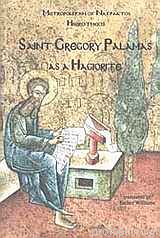0
Your Καλαθι
St. Gregory Palamas as a Hagiorite
Έκπτωση
20%

20%

Περιγραφή
This book presents the life, work and teaching of St Gregory Palamas as they relate to his identity as a monk of the Holy Mountain. In the consciousness of the Church as a whole, St Gregory Palamas, Archbishop of Thessaloniki, is not just a great Father of the Church and an Ecumenical Teacher, but belongs to the company of the Three Hierarchs and the three great Theologians of the Church, as "The Fourth Hierarch and Theologian".
Drawing on information provided by St Philotheos, St Gregory's biographer, the author describes the Saint’s life from childhood, before he moved to the Holy Mountain. Subsequently we see the Saint as monk, priest, Abbot and Metropolitan, and it is stressed that he was a true Hagiorite, not only because he stayed on the Holy Mountain, but because he lived the life of the Holy Mountain. We learn about the Saint’s gifts and virtues, but also his temptations, which he regarded as a special blessing from God. The Saint's teaching is an expression of the life which he encountered on the Holy Mountain, that is to say, the hesychastic way of life which is the essence of the Orthodox tradition.
The core of the Saint's teaching can be found in his dispute with the speculative philosopher Barlaam. He overturned Barlaam’s erroneous views and laid down the theological conditions for noetic prayer. He demonstrated that noetic prayer is found in the tradition of the Church, and is not just the prerogative of monks, but can be practised by all Christians. By setting out in theological terms the value of fasting, vigil, tears and compunction, and also analysing the importance of the senses during the practice of noetic prayer, he teaches us that the body cannot be overlooked in man’s effort to be purified. In fact, he explains that the grace of God acts in the soul and from there is carried over into the body as well.
Drawing on information provided by St Philotheos, St Gregory's biographer, the author describes the Saint’s life from childhood, before he moved to the Holy Mountain. Subsequently we see the Saint as monk, priest, Abbot and Metropolitan, and it is stressed that he was a true Hagiorite, not only because he stayed on the Holy Mountain, but because he lived the life of the Holy Mountain. We learn about the Saint’s gifts and virtues, but also his temptations, which he regarded as a special blessing from God. The Saint's teaching is an expression of the life which he encountered on the Holy Mountain, that is to say, the hesychastic way of life which is the essence of the Orthodox tradition.
The core of the Saint's teaching can be found in his dispute with the speculative philosopher Barlaam. He overturned Barlaam’s erroneous views and laid down the theological conditions for noetic prayer. He demonstrated that noetic prayer is found in the tradition of the Church, and is not just the prerogative of monks, but can be practised by all Christians. By setting out in theological terms the value of fasting, vigil, tears and compunction, and also analysing the importance of the senses during the practice of noetic prayer, he teaches us that the body cannot be overlooked in man’s effort to be purified. In fact, he explains that the grace of God acts in the soul and from there is carried over into the body as well.
Κριτικές
Δεν βρέθηκαν δημοσιεύσεις



